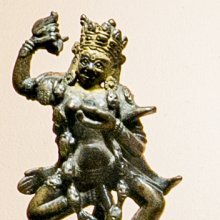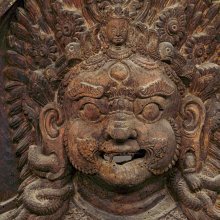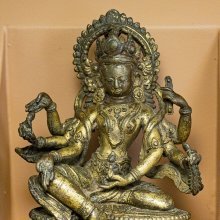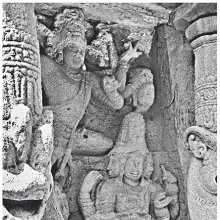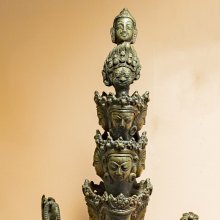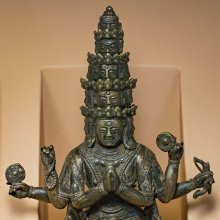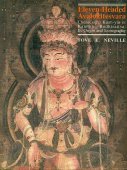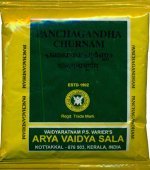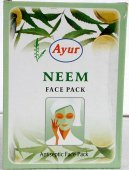Head: 4 definitions
Introduction:
Head means something in Hinduism, Sanskrit. If you want to know the exact meaning, history, etymology or English translation of this term then check out the descriptions on this page. Add your comment or reference to a book if you want to contribute to this summary article.
Images (photo gallery)
(+323 more images available)
In Hinduism
Yoga (school of philosophy)
Source: ORA: Amanaska (king of all yogas): A Critical Edition and Annotated Translation by Jason BirchHead (meditation) (i.e., ‘meditating on the back of the head’) forms part of the various Teachings or Techniques (saṅketa) on Layayoga, according to the Dattātreyayogaśāstra verse 21-26.—Note: The Dattātreyayogaśāstra’s techniques (saṅketa) of Layayoga can be summarised as meditation on the void, gazing on the tip of the nose, meditating on the back of the head, gazing between the eyebrows, meditating on the forehead and brow, meditating on the two big toes and lying on the ground like a corpse.

Yoga is originally considered a branch of Hindu philosophy (astika), but both ancient and modern Yoga combine the physical, mental and spiritual. Yoga teaches various physical techniques also known as āsanas (postures), used for various purposes (eg., meditation, contemplation, relaxation).
Gitashastra (science of music)
Source: Shodhganga: Elements of Art and Architecture in the Trtiyakhanda of the Visnudharmottarapurana (gita)The Head (in Sanskrit: Śiras) refers to one of various Organs of Utterance (sthāna), according to the Viṣṇudharmottarapurāṇa, an ancient Sanskrit text which (being encyclopedic in nature) deals with a variety of cultural topics such as arts, architecture, music, grammar and astronomy.—During the practise of Vocal Music, the proper production of the concerned sound is always considered as very important. Sthāna or ucchāraṇasthāna is the place of articulation of sound. Bhattojidīkṣita in his Siddhāntakaumudī said about ten kinds of sthāna (i.e., the organs of utterance), e.g., śiras (head).
Gitashastra (गीतशास्त्र, gītaśāstra) refers to the ancient Indian science of Music (gita or samgita), which is traditionally divided in Vocal music, Instrumental music and Dance (under the jurisdiction of music). The different elements and technical terms are explained in a wide range of (often Sanskrit) literature.
Natyashastra (theatrics and dramaturgy)
Source: Shodhganga: Elements of Art and Architecture in the Trtiyakhanda of the Visnudharmottarapurana (natya)The Head refers to one of the major Body Parts with which are associated various gestures and expressions (in Sanskrit Dramas), as conveyed through Āṅgikābhinaya: one of the four divisions of Abhinaya or “ways to convey or represent one’s emotion to others”, according to the Nāṭyaśāstra and the Viṣṇudharmottarapurāṇa, an ancient Sanskrit text which (being encyclopedic in nature) deals with a variety of cultural topics such as arts, architecture, music, grammar and astronomy.—The āṅgikābhinaya includes the histrionic representation of the limbs which is simply known as physical gestures. The aṅgas i.e., major classification of the body parts are six in numbers viz., head, hands, chest, sides, waist and feet.
In the Viṣṇudharmottarapurāṇa, seven types of movements of the Head are recorded. These are termed as:
- ākasmika,
- kampita,
- udyuta,
- vidhuta,
- parivāhita,
- udvāhita and
- abadhuta.

Natyashastra (नाट्यशास्त्र, nāṭyaśāstra) refers to both the ancient Indian tradition (shastra) of performing arts, (natya—theatrics, drama, dance, music), as well as the name of a Sanskrit work dealing with these subjects. It also teaches the rules for composing Dramatic plays (nataka), construction and performance of Theater, and Poetic works (kavya).
Shilpashastra (iconography)
Source: Shodhganga: Elements of Art and Architecture in the Trtiyakhanda of the Visnudharmottarapurana (shilpa)The Head is denoted by the Sanskrit term Mūrdhā, and represents one of the various body parts whose Measurements should follow the principles of ancient Indian Painting (citra), according to the Viṣṇudharmottarapurāṇa, an ancient Sanskrit text which (being encyclopedic in nature) deals with a variety of cultural topics such as arts, architecture, music, grammar and astronomy.—In the third part of the Viṣṇudharmottarapurāṇa, chapters 35th to 43rd are dedicated to the Painting of different portraits of different kinds of men and women. The measurement of almost all the body parts that should be maintained in a picture have been presented here. For example, the Head (pārṣṇi) should be 12 aṅgulas.

Shilpashastra (शिल्पशास्त्र, śilpaśāstra) represents the ancient Indian science (shastra) of creative arts (shilpa) such as sculpture, iconography and painting. Closely related to Vastushastra (architecture), they often share the same literature.
See also (Relevant definitions)
Starts with: Head decoration, Head of the fruit, Headache tree, Headache vine, Headgear.
Ends with (+9): Arrowhead, Arum-leaf arrowhead, Arumleaf arrowhead, Bald head, Big head, Broadleaf arrowhead, Broomhead, Bulltongue arrowhead, Cat-head, Deer head, Ebony blackhead, Forehead, Goat head, Lance-leaf arrowhead, Old world arrowhead, Polly red head, Raised head, Red-head, Snakehead, Stick-head.
Full-text (+7911): Murdha, Mauli, Shiras, Shirsha, Uttamanga, Mastaka, Kesa, Shikha, Munda, Cuda, Shirobhushana, Mundana, Adhomukha, Shirasija, Unnatashiras, Apida, Ravana, Shirshaka, Ucchirshaka, Trishiras.
Relevant text
Search found 480 books and stories containing Head; (plurals include: Heads). You can also click to the full overview containing English textual excerpts. Below are direct links for the most relevant articles:
The gods of northern Buddhism (by Alice Getty)
Manusmriti with the Commentary of Medhatithi (by Ganganatha Jha)
Verse 3.238 < [Section XIV - Method of Feeding]
Verse 8.114 < [Section XVIII - Oaths and Ordeals]
Verse 8.218 < [Section XXXVI - Non-Payment of Wages]
Kathasaritsagara (the Ocean of Story) (by Somadeva)
Vetāla 6: The Lady who caused her Brother and Husband to change Heads < [Appendix 6.1 - The Twenty-five Tales of a Vetāla]
Chapter LXXX < [Book XII - Śaśāṅkavatī]
Chapter CXVI < [Book XVII - Padmāvatī]
Chaitanya Bhagavata (by Bhumipati Dāsa)
Verse 2.10.148 < [Chapter 10 - Conclusion of the Lord’s Mahā-prakāśa Pastimes]
Verse 2.19.106 < [Chapter 19 - The Lord’s Pastimes in Advaita’s House]
Verse 2.10.6 < [Chapter 10 - Conclusion of the Lord’s Mahā-prakāśa Pastimes]
The civilization of Babylonia and Assyria (by Morris Jastrow)
Related products
(+78 more products available)
